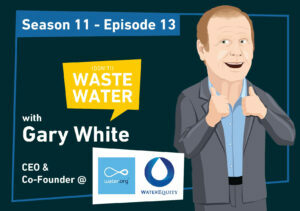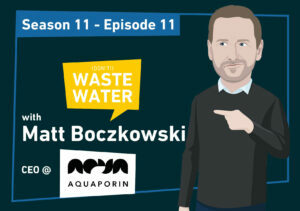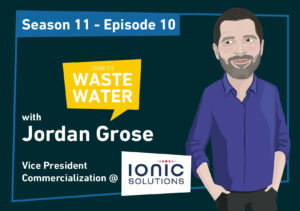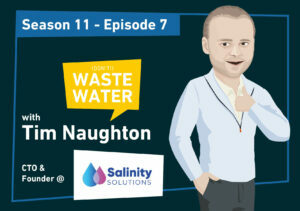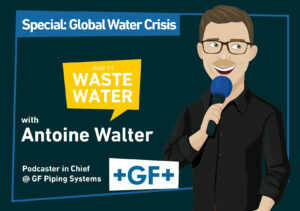with 🎙️ Manaf Farhan – CEO & Co-Founder of EMG International (we discuss anaerobic digestion!)
💧 EMG International is a leading company in Anaerobic Wastewater treatments, with a pretty unique take on anaerobic digestion.
This episode is part of my series of Industrial Water. Check it out! 😀
What we covered:
🍏 How Anaerobic Fluidized Bed Digestors enable to produce 4 times more energy than they consume to treat wastewater
🍏 How they can be fully automated to let industrial players focus on their production lines
🍏 4 good reasons to learn a new wastewater acronym with the AFBD’s benefits.
🍏 How “hands-on” was literal when he started EMG together with his brother in the 90s
🍏 The similarities and differences between AFBDs, MBBRs and Microbial Fuel Cells
🍏 How to valorize biogas with the best efficiency
🍏 How anaerobic digestion is actually a replica of what’s happening in… our body!
🍏 How EMG International addresses the industrial wastewater treatment market (and beyond!)
🔥 … and of course, we concluded with the 𝙧𝙖𝙥𝙞𝙙 𝙛𝙞𝙧𝙚 𝙦𝙪𝙚𝙨𝙩𝙞𝙤𝙣𝙨 🔥
Teaser:
Infographic: Anaerobic Digestion
LinkedIn-Infographic-1Resources:
➡️ Send your warm regards to Manaf on LinkedIn
➡️ Have a look at EMG International’s website

is on Linkedin ➡️
Table of contents
- What we covered:
- Teaser:
- Infographic: Anaerobic Digestion
- Resources:
- Full Transcript:
- Starting with Anaerobic Digestion
- Founding EMG to leverage Anaerobic Digestion breakthroughs
- How does Anaerobic Digestion look like on a plant?
- Anaerobic Fluidized Bed Digestion – a new wastewater acronym
- Anaerobic Digestion as a Wastewater Treatment
- Can anaerobic digestion be a net positive wastewater treatment?
- The differences between anaerobic digestion and microbial fuel cells
- Considering Carbon Footprint
- Anaerobic Digestion as a source of heat, water and power for industrial processes
- Monitoring organic loads in anaerobic digestion
- Automating an anaerobic digestion plant
- The business side of an anaerobic digestion company
- What about international expansion?
- The sweet spot of anaerobic digestion
- How Anaerobic Digestion all started for EMG International
- Rapid fire questions.
- Other Episodes:
Full Transcript:
These are computer generated, so expect some typos 🙂
Antoine Walter:
Hi Manaf. Welcome to the show. Thank you for having me actually. It’s interesting because we are in, in Pennsylvania with you today. And I like to start a new life, like usually with a postcard. What can you tell me about the place where you’re at right now? Something crispy is something really strange. I don’t know. You tell me.
Manaf Farhan:
Well, I’m sitting in a media, Pennsylvania today, which is right outside of Philadelphia. Philadelphia is between Washington and DC. We’re having a cool spring. So it’s a little bit of a late bloom for the trees and the flowers, but there are some flowers out there and it’s really pretty handsome, nice crisp spring day. And it’s a great to talk about wastewater.
Antoine Walter:
Well, actually, when preparing for that discussion, we were we’ll have together. And as I shortly alluded to you, when we were just chatting before hitting the record button, when I was scrolling your websites, I stumbled upon a video, which is not your everyday video you see on the, on the water industry company. And it was an interview led by Pennsylvania States Senator an interview of you. So sometimes you see that the contrary of what a professional interviewing a politician and asking him some crispy stuff about what if things of the environment or whatever. And here it’s the opposite. You, you got interviewed by a Senator, a former state Senator, Pat Vince. So what’s the story about that? Is there a funny anecdote about that one?
Manaf Farhan:
Yeah, that, that was an interesting project. That was one of the earlier projects we did in the early two thousands. It was at a dairy farm to treat cow manure and that project was funded by the state of Pennsylvania and the Senator at the time, Senator, Pat Vance was interested in sustainability and promoting that kind of project and that kind of work. And so she asked if we could do an interview and it turned out to be pretty interesting.
Starting with Anaerobic Digestion
Antoine Walter:
So that was on a dairy farm and it touched your field of expertise, which is an Anaerobic digestion. And if I want to be provocative, I have to start with that one. How do you get interested in Anaerobic digestion?
Manaf Farhan:
Yeah, it’s interesting. The story of life, right? How things happen. So I studied civil engineering and undergraduate at Notre dame or Notre Dame university. Not, not, you’re not you’re done. And then from there I studied civil engineering again and I studied environmental engineering. I turned from civil to environmental for graduate school. So I was interested in water and wastewater treatment and sustainability for a while, a long time. This is since graduate school and my dissertation was in anaerobic digestion. So that’s how it started for me.
Antoine Walter:
So you did your dissertation on that, so you, you, your PhD, right?
Manaf Farhan:
Correct. Yes. At the university of Pennsylvania.
Antoine Walter:
And since then it was a continuous love with that field. Yeah. Yeah.
Manaf Farhan:
Well, I, I did an in-depth dive into the process and the science of anaerobic digestion and I studied different reactors and how they perform. I studied them for a year and a half detailed analysis of performance of different digesters and, you know, was able to compare and contrast different technologies. And after that, I just started EMG in 1996 with my brother. And we have been ever since we’ve been promoting this technology and building these systems.
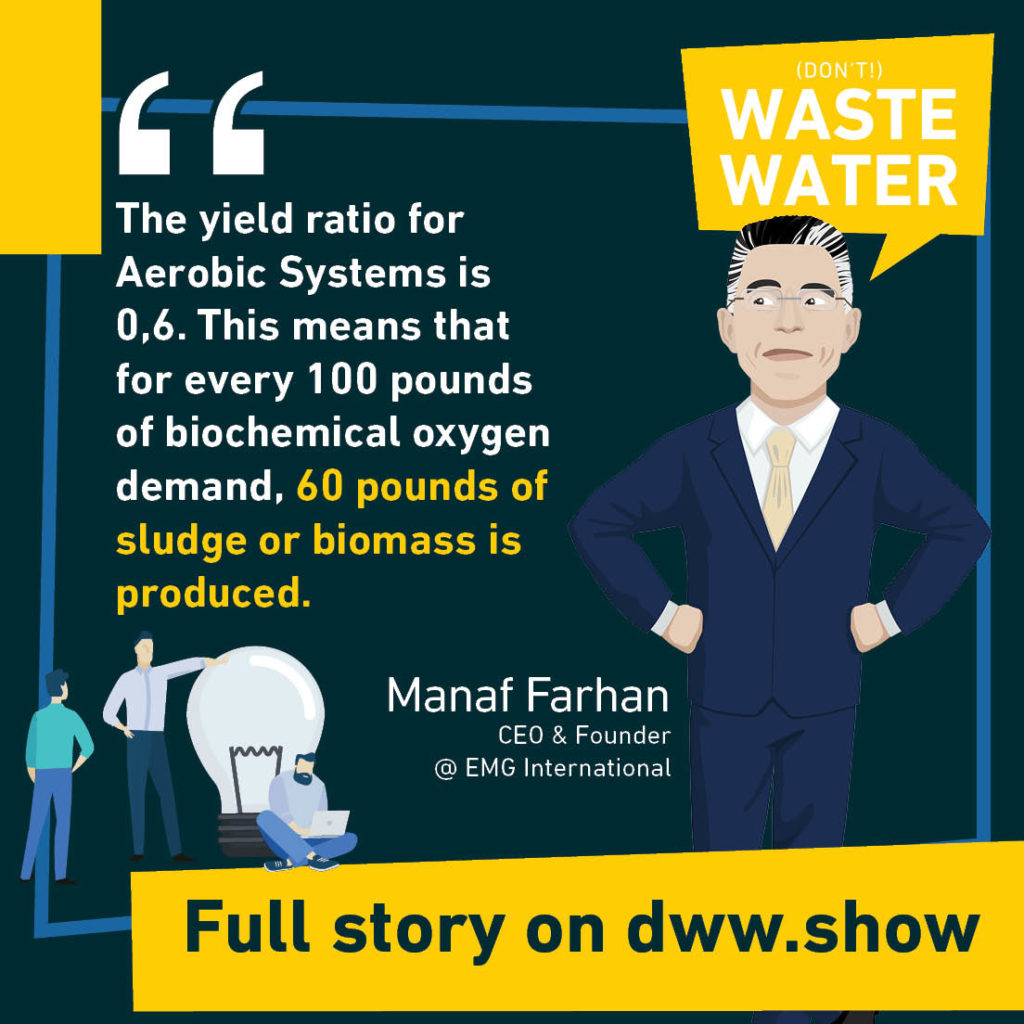
Founding EMG to leverage Anaerobic Digestion breakthroughs
Antoine Walter:
So EMG is your, your company today that you you’re the CEO, right? So you’re the founder and CEO and 25 years you, you dedicate to that anaerobic digestion and a bit more, I guess. Yeah, actually I was sold to that interview by your colleague, Paul Jarrett, because he told me that you just took anything that was existing within anaerobic digestion, everything, which was wrong with it. And you made it better. Sounds good. But I like to start to that actually, what was wrong with anaerobic digestion? You mentioned that you, you, you were studying that in depth. So what was it that needed to be corrected within that field?
Manaf Farhan:
Sure, sure. First, my friend who introduced us is Jared Paul. And Oh, sorry. It does not, not a problem, not a problem. So yeah, initially in the seventies, eighties, and even nineties, anaerobic digestion was primarily used in wastewater treatment plants that are municipal to treat this for wastewater, which is typically treated aerobically with the presence of oxygen. And when that’s done, it produces sludge aerobic systems are energy consumers, and they produce a lot of bacteria or sludge. The yield ratio for Aerobic systems is 0.6. Meaning for every 100 pounds of biochemical oxygen demand, 60 pounds of sludge or biomass is produced. So historically anaerobic digestion has been used in the United States at least to treat the sludge or the biomass that’s produced from municipal wastewater treatment plants. It takes that sludge and they treated anaerobically and they produce biogas. So it’s a secondary treatment or as an afterthought.
Antoine Walter:
So you have the, the waterline in the waste water treatment plants, and the water line is usually the one everybody focuses on and, anaerobic digestion is on the sludge line. So you extract your sludge from your rated Baskins and that you drive it to the digester and hopefully it produces some within. But what you’re saying is that there was a better use to make from the technology and, and probably a better yield.
Manaf Farhan:
Correct? So we focus on using anaerobic digestion for treating industrial wastewater and the easy target. The primary target for us is food and beverage manufacturing because obviously food and beverage manufacturing is high strength. It is biodegradable. I see behind you, there’s a sign for a Cola product. So, you know, when, when they produce soda, for example, they use sugar and they use flavorings and the sugar is highly biodegradable. And we just put that through an anaerobic digester to produce methane or bio gas instead of producing more sludge to neutralize the wastewater.
Antoine Walter:
So you basically erase one step. You say, you don’t need to go through this Aerobic treatment, which produces sludge. You can directly drive waste water in you take methane out and kind of already treated water at the outlet of the digester so that the digester is no longer on the, on the sideline. It is the main treatment.
Manaf Farhan:
That’s a very smart way to look at it, Antoine. Basically, instead of I mentioned earlier that the yield for aerobic systems is 0.6, the yields for anaerobic systems or anaerobic processes is close between 0.03 to 0.06. And so it’s between 10 to 20 times less meaning that you produce for every 100 pounds of BOD, you produce between three to six pounds of sludge. And so the process itself is slower. It’s net energy producer. It produces less biomass as a by-product and it basically converts the organic starches sugars, alcohols, uh, proteins, whatever fats into biogas, CH4 and CO2.
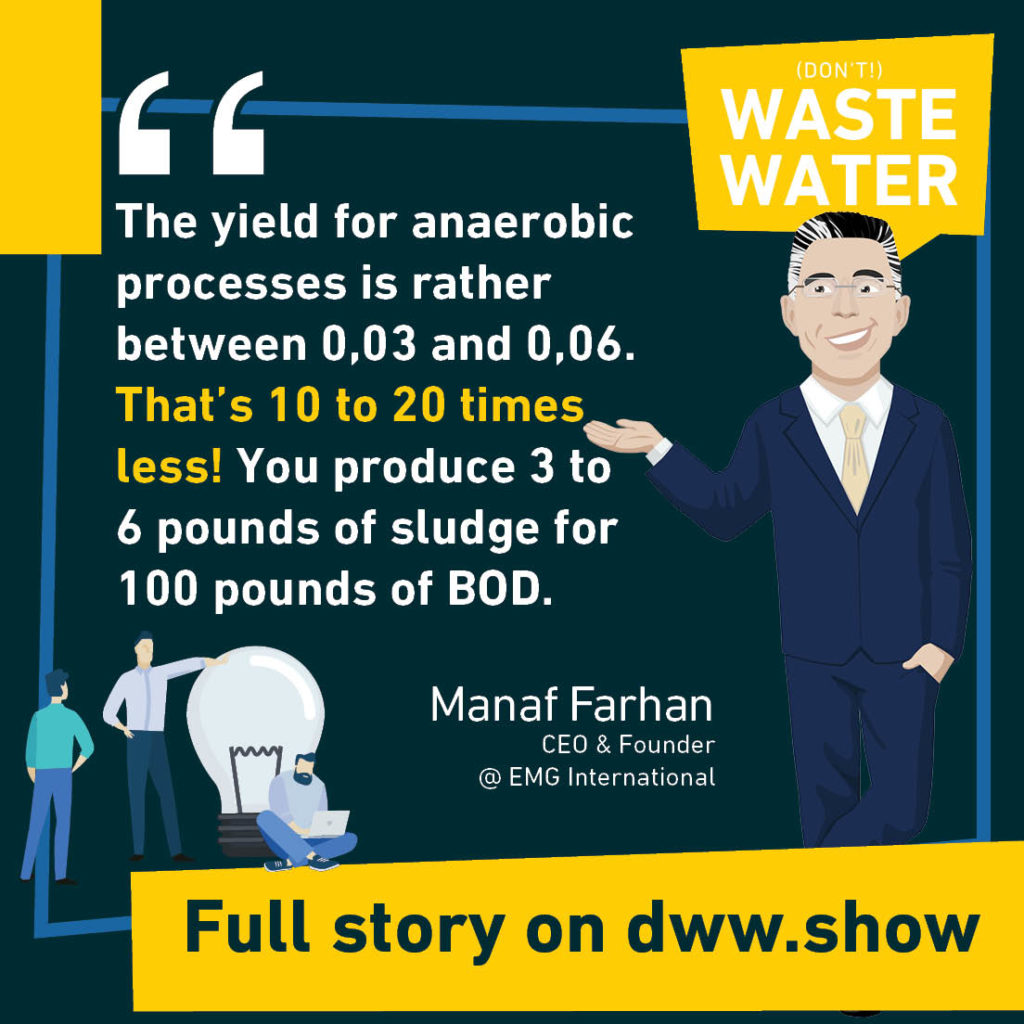
How does Anaerobic Digestion look like on a plant?
Antoine Walter:
How does that look like on the plants? Is it those cylinder that we see in the conventional plants? Or does it look differently?
Manaf Farhan:
Yeah, one of the questions you asked a second ago is how is the technology better now? How has the anaerobic digestion technology better? Now, as I mentioned, first in a municipal waste water treatment plant, the digesters anaerobic digester is where large completely mixed systems. So it’s a big tub that’s completely mixed and they design it for a hydraulic retention time of between 18 and 20 days, meaning that the water would stay in the reactor for an average of 18 to 20 days, because in those big mixed systems, the hydraulic retention time is the same as the mean cell residence time. Meaning the average time that a bacteria particles stays in the reactor. So they design them so that the bacteria stays in the reactor for about 18 to 20 days, because the most sensitive bacteria in the anaerobic process are the methanogens and their doubling time is between 12 to 14 days. And so to be safe, they designed them to about 20 days, 18 to 20 days. So the next step was to go from these conventional completely mixed digesters to a better process. And that transformation happened when automation came on the scene in the late eighties, early nineties, and then it became more ubiquitous. There’s more process controls. Now there’s remote access. There’s better reactor configurations. So in the last 20 to 30 years, that’s transformed the reputation and the performance of anaerobic digesters.
Antoine Walter:
You mentioned the reactor configuration. If I got it right by scrolling your websites, actually, it’s not just a tank that you have. There is something inside the tank.
Manaf Farhan:
Correct? So the process that we have is called the anaerobic fluidized bed reactor. AFV or AFBD that has been digested.
Anaerobic Fluidized Bed Digestion – a new wastewater acronym
Antoine Walter:
That’s cool. Because in every single podcast, I have a new combination of letters. You know, we had MABR, MBBR and MBR. Now we are at AFDR?
Manaf Farhan:
AFBD! It Is a silo or a tank. It’s a vertical tank. We flow from the bottom up. We add a bio carrier as you know, bacteria like surfaces. And the bio carrier is a small particle, like the size of sand and we flow upward. And so the balance between the up-flow and the weight of the particle, the mass of the particle, given the force, now that balance is causes it to be fluidized or it’s swims around a gentle Brown in motion. And then we inoculate the bio carrier with the bacteria and the bacteria lives on the surface of these particles. And by doing that, we have a very nice hybrid model where it’s a completely mixed reactor and it’s an attached growth reactor. So it’s, there is a buyer carrier. So typically when you have bacteria living in water, you get bacteria populations or mixed liquor, volatile, suspended, solids. I know you like acronyms, I’ll give you more MLVSS. So the MLVSS of bacteria living in suspension is typically about between 3000 and 5,000 milligrams per liter. The bacteria population that we get in our AFBD system is between 40,000 and 60,000 milligrams per liter. And so we have upwards of 20 times higher biomass population, and you know, more biomass is a more stable process.
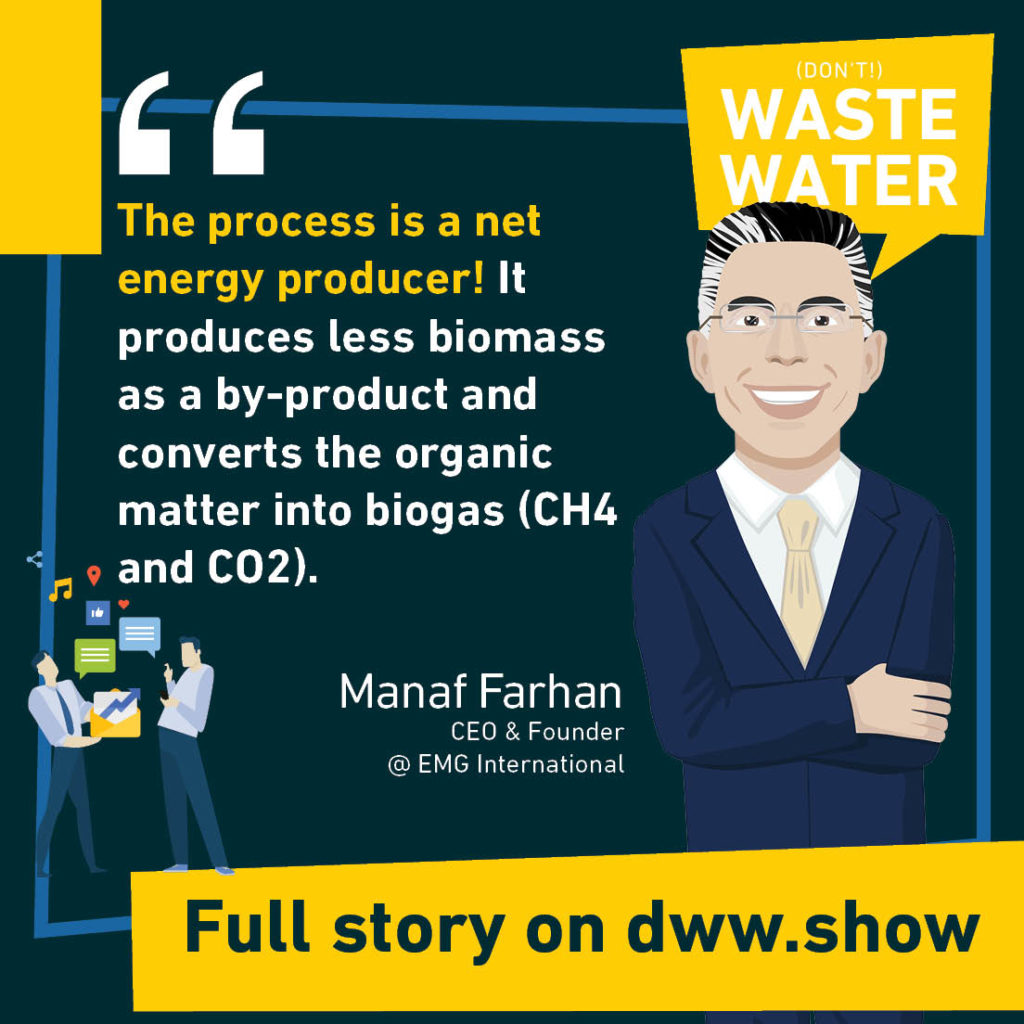
Antoine Walter:
So you mentioned the acronyms, how different, if it’s if, if the Bio-carrier is in movement, if it’s free days bed, how different is it from an anaerobic MBBR? So moving bed bioreactor
Manaf Farhan:
Fluidized bed, technically is in the category of moving bed. Bioreactors. The difference primarily is in the shape and the size of the media. Typically MBBRs use plastic balls as the media and they flow up and then they swim around a little bit. It’s not completely mixed, it’s a moving bed. And on top they put some kind of a constraint or a net to make sure that these plastic balls don’t leave. So the AFBD, the fluidized bed process is similar to an MBBR. It is a moving bed reactor. It’s a fluidized bed. It’s not the same because it’s different media. And our cross-sectional area is much smaller because of the reactor is, is more vertical.
Anaerobic Digestion as a Wastewater Treatment
Antoine Walter:
So you put raw wastewater in. So this industrial wastewater, so high strength, wastewater, and at the outlets, what do you have. To which level is it treated and what would you put behind one of these AFBD?
Manaf Farhan:
Sure. So we do our process usually has equalization and the fluidized bed reactor. We use equalization to allow the wastewater to start to, to break down for hydrolysis liquefaction and the beginning of the acid generation process. And when we do that, the precursors to methane generation are the short chain volatile, organic acids and acidic acid. And primarily it’s a scenic acid that drives the methane generation. So we want to get to the point where as much of the wastewater has been broken down and volatilized, and even into the volatile assets and ready to go into the methane generation. Once we generate the biogas, which is a combination of CO2 and CH4 that’s collected and processed, and we recover the electricity from it and waste heat on the backside. It depends on the discharge limits. Most of our systems for wastewater treatment in the food and beverage industry go into a sewer that depends on the industrial user permit.
Manaf Farhan:
That’s what they’re called here in United States. Are you or a significant industrial use permit where the treated wastewater has to go to a sewer and they tell you, for example, the bod has to be under either 300 milligrams per liter, or under say a thousand pounds per day, you have a limit. So it depends on where we are in that spectrum. If we can discharge to the sewer or the client can discharge the sewer without polishing, we would go straight to the sewer. Or if fellowship is required, we would put another polishing unit after our system. And it could be even to the point where it could be streamed level discharge, where we can just discharge it to the environment under a different permit, which here in the United States is called a Speedy’s or nip. These permit, a national pollutant discharge elimination system, or SP a state pollutant discharge elimination system.
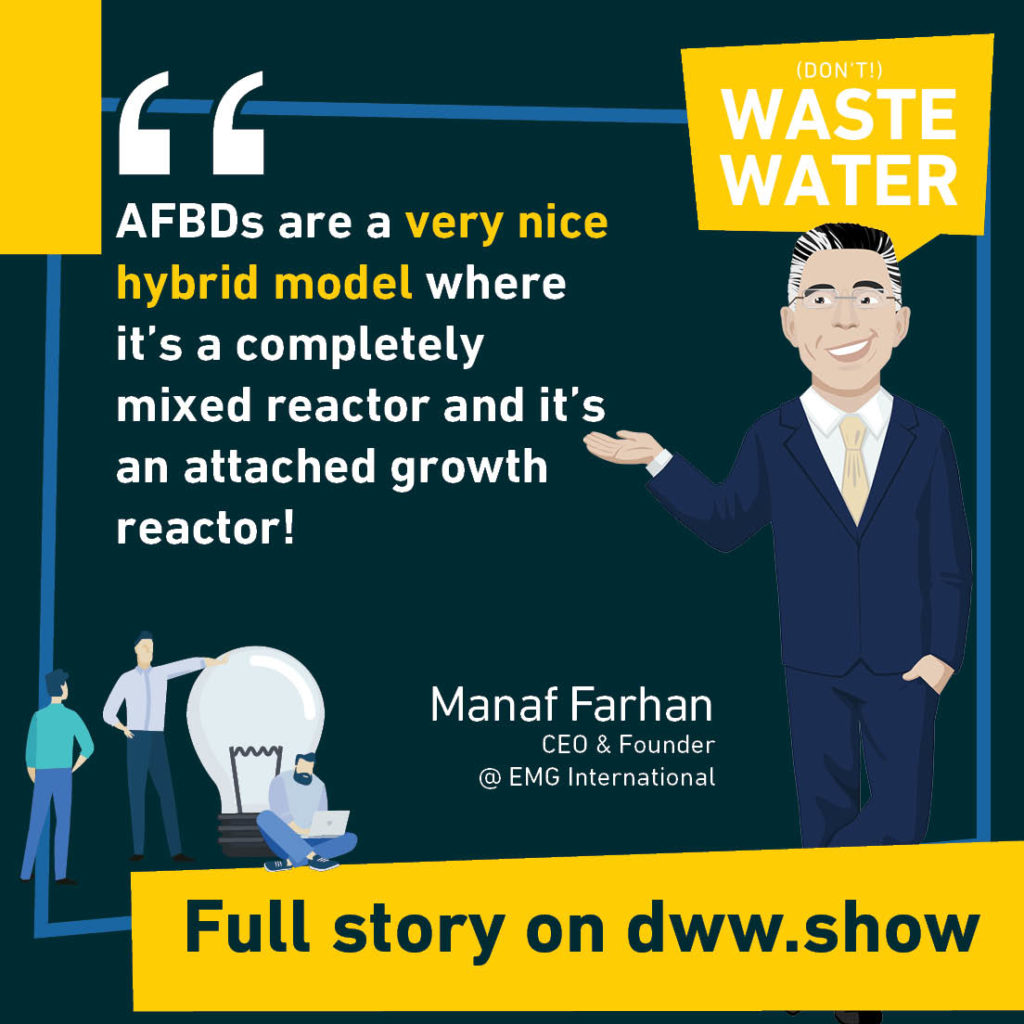
Antoine Walter:
If I get it right, your sweet spot. In terms of application, is this high strength wastewater you usually would find in, in food and beverage, what would be the top three reasons for me, let’s say that’s the beauty of that podcast. I can imagine many things. Let’s say I run a plant, a soda plant. What would be your, your top three arguments to tell me why your technology would be the best suit for me
Manaf Farhan:
Today? We’re all aware of our impact on the environment as human beings you know, with industries and the goal is for us to minimize impact on the environment. So the first and biggest driver in my mind, that’s why I got into this business is to reduce the impact on the environment. And so the soda manufacturer might make delicious soda, and they might be very excited about their products and they keep continuously creating new products that help them into the marketplace. But every time we do that, there’s an impact on the environment in terms of generating more wastewater with more pollutants. And so the first thing that I would say is, you know, these manufacturers can put an anaerobic fluidized bed, digestive system there and reduce their carbon footprint, reduce the amount of waste that they put into the sewer or discharge into the environment.
Manaf Farhan:
And sustainability is a big, important part. And a lot of manufacturers are very responsible and very aware of the importance of reducing the carbon footprint and their impact on the environment. When we put a fluidized bed digester in to treat an industrial wastewater, we can reduce the organic discharge to a sewer by 80, 90, 95%. Sometimes if we put polishing, we can reduce it by 99% and then we can recover bio gas, which we can make into electricity and recover waste heat from that application. And so we can then reduce the amount of energy that they use, the amount of electricity they consume per unit produced, and the amount of natural gas they consume for you to produce. So the biggest in my mind, the biggest driver is to be responsible and to manufacture sustainably. The other thing is reducing costs because a lot of times they produce, they put these pollutants to this sewer and they have to pay a surcharge fee. So those pollutants go to a municipal wastewater treatment plant that treats the wastewater aerobically, which is an energy intensive process. So, you know, that is going to have a bigger impact on the environment. And so when we put the process treatment onsite, it is a very small footprint because a lot of times these manufacturers are space limited. They can reduce their discharged to the sewer and they can reduce the cost that they pay with that.
Can anaerobic digestion be a net positive wastewater treatment?
Antoine Walter:
You mentioned the, the energy, how far are you from being energy positive with your systems?
Manaf Farhan:
We’re there! So typically the bed digester has parasitic energy requirements of somewhere between 20 to 30%. And so the energy required to run our system is between 20 to 30% of the total energy that we produce.
Antoine Walter:
Okay. So said differently, you produce four to five times more energy than, than what you use.
Manaf Farhan:
Yep. Yeah. Three to four times is right about there. Yeah. Okay.
Antoine Walter:
Because, you know, wastewater treatment plants which are net energy positive or a target for a while in, in many places, but it turns out here you’re not even made it, but you go beyond that.
Manaf Farhan:
Yeah. And you know, the exciting thing here is that you mentioned cutting out the aerobic process and putting the anaerobic process in there so that we don’t produce more sludge. Yes, we don’t produce as much sludge. We also produce energy. And so it’s not requiring energy for us to treat the waste and now we’re turning waste to energy. And the other thing is of course, where populations are growing, demands are growing. And so a lot of these manufacturers have to increase their production. And when they do that, they have to make a decision. Do we generate more waste? Do we pay more money? They put these wastewater famous systems onsite. It enables them to expand because they’re generating, they’re treating their waste before they put it into the sewer.
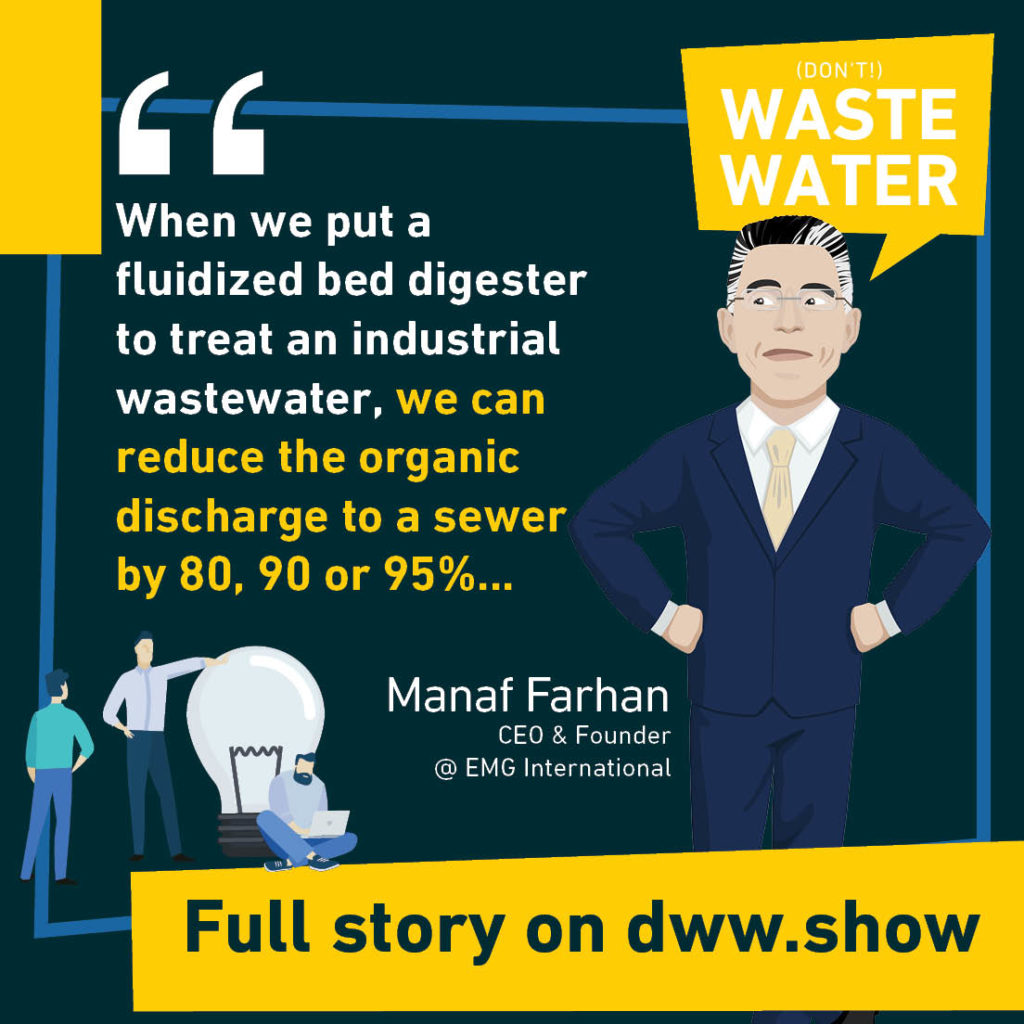
The differences between anaerobic digestion and microbial fuel cells
Antoine Walter:
Many questions here. There are many things I have to unpack in what you just said, but let, let me, let me stay for a second on this energy topic. How different is your technology to a microbial fuel cell?
Manaf Farhan:
Sure. So a microbial fuel cell is it converts the chemical energy to electrical energy by the organisms reactions. They basically create that differential between the two sides of the reaction to create electron flow, to generate electricity. So for us here, we use a biochemical process to convert the organic portion into another compound, which is bio gas. So in an aerobic process, for example, it converts the bacteria, consume their organics, the carbon based compounds, and they produce new cell mass and CO2 and an anaerobic process in the bacteria consume the BOD and we produce mostly biogas. So we’re just converting the organics from the carbon chain into CO2, and CH4 whereas in a microbial fuel cell, they just convert the chemical energy into electrical.
Antoine Walter:
Well, it depends if, if it’s a fuel cell or a next realizes cell, but you’re right on the, on the principle. And what do you do with that biogas? Is it a cogeneration where you make some heat and some electricity, or is there another use? What, what’s the most common one?
Manaf Farhan:
There are several uses for the biogas in my experience and what we’ve been doing for 25 years, the most profitable way to use that bio gas is to put it to a combined heat and power system, which is typically a reciprocating engine that burns the methane gas, produces electricity. And then we recover about 50% of the BTU value of the waste heat. And so if we start with a 10 million, BTU’s a day, we convert roughly between 30 to 35% to electricity. And the other 50% of that 10 minute BTU goes to waste heat that’s recovered. And so we reduce the natural gas consumption requirements for a plant, and we reduce electricity consumption by producing our own electricity.
Considering Carbon Footprint
Antoine Walter:
You mentioned the carbon footprint and what you just explained contributes to that carbon footprint elements. Another thing which I would see with the carbon footprint is that actually we always looking at CO2 because it’s, it’s the, these carbon emissions, but methane is much worse when you look at just a, the greenhouse effect, things about that. There must be a 20 or 25 times ratio between, between methane and CO2. So if you’re more efficient in transforming organic load into methane and making something useful out of it, instead of just discharging everything to a sewer where a part of it would be just going to the atmosphere one way or the other, do you see here also a positive impact of what your, what you’re doing or is it really negligible?
Manaf Farhan:
It is very positive. I was just mentioning a second ago that one of the things that we use this way, the method and byproduct for is to the combined heat and power CHP units. They’re also convening that fuel, the bio gas can be sent to a boiler site to produce heat, or we can purify the bio gas and put it into a pipeline gas quality, which is, you know, it’s more expensive and it has to be a bigger scale. But to your point, when we treat the organics, you have to keep in mind that, you know, they come from sugar. For example, in the soda process, they might come from dairy and the cheese manufacturing process, so that those organics were produced in the previous calendar year. So they’re very, short-lived the conversion of the production of the sugar or the organics or the milk.
Manaf Farhan:
It’s a very short cycle. And so if it were to go to a wastewater treatment plant, they were treated aerobically. So they have to spend energy to treat it. And of course the by-product of aerobic digestion is more sludge and CO2. When we treated anaerobically, we produced less sludge and we produced methane gas, which is a fuel. And so we’re saving on the CO2 production. If it were to be treated aerobically, we’re producing a fuel that can be variant to generate electricity. And because of the short cycle, that, that one year cycle, this is considered not a net new source, this is considered a zero net emissions because of that fact. And so, yes, we would produce the fuel that actually would reduce the carbon footprint and would reduce their waste discharge off site.
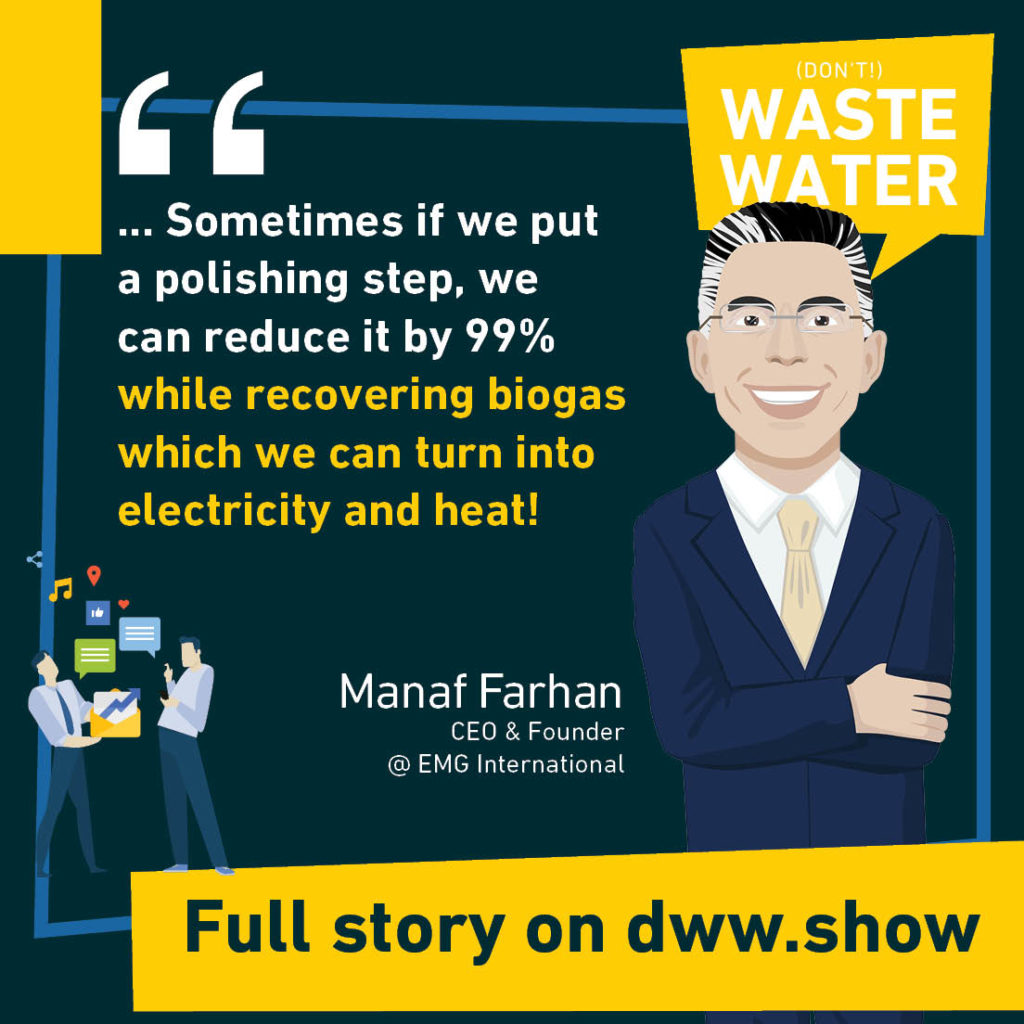
Anaerobic Digestion as a source of heat, water and power for industrial processes
Antoine Walter:
There’s another element in what you said before, which, which is intriguing to me, you know, if, if I’m still that industrial owning that plant to me so far, wastewater was, was more waste than water and was something which is kind of annoying with my process because I have that as a byproduct and I have to pay for written and everything. And now what you’re saying basically is that this is a resource. It is energy for my plant. It is a stuff I can extract. So would you say that for an industry, it, it changes a bit the way they are looking at their waste water, because it’s not just one line on the, on the bill they have from the utility. It’s also something where they can say, Hey, the heat of my plans, or they interested from my plants comes from that actual by-product from my process.
Manaf Farhan:
Absolutely. I think your, you have you’re right on there in the past. Industries have looked at wastewater as a tax or as a liability. They look at it as something that they have to pay money for to produce, to be in business where with our solution, with our technology, you can actually now convert that liability into an asset. And that’s part of the reason why we look at industrial wastewater because it has high concentrations of BOD it’s effectively sugar water, or it has, you know, milk waste. And it has other byproducts in it that are organic based it’s food waste that we’re going to convert into energy. We have basically converted a liability or a problem into an asset. The issue that we fight the most is acceptance because people still don’t trust wastewater treatment. They still don’t trust that it can be done effectively and reliably. And they think, you know what? I’ll just put in the sewer and pay that money and not have the headache. And that’s where our process comes in. And we’ve actually changed a lot of people’s outlook on this because it’s reliable, it’s automated small footprint and it makes their life easier. And they can then say that they’re, yes, they’re producing more, but they’re reducing their carbon footprint as they’re doing it. So they’re producing sustainably.
Antoine Walter:
I’ve seen it on your websites that you, you mentioned as an asset from your, your AFBD, that it recovers pretty fast and pretty easily from upsets, but what upsets your system? What, what can happen on the stream that upsets your bacteria? I guess
Manaf Farhan:
I would say, you know, there are several things that can happen in an industrial process, and most of them are human error. You know, obviously no one is perfect. And so this is where I would try to automate as much as possible. When you look at a plant making cake or a soda or packaging milk, they might have a batch that’s out of spec that set in the tank for too long, or someone added too much sugar, or, you know, something happened and it’s just off spec and they need to get rid of it. Well, they have to get rid of it because they have to get the next batch in and produce and bottle. So the only way to get rid of it is to put it down the drain. Some manufacturers have the ability to segregate that high strength waste and put it into a tank and ship it off and make it someone else’s problem.
Manaf Farhan:
But when a system is designed to handle say 5,000 pounds of BOD per day, by chemical oxygen demand, and all of a sudden you give it a waste batch that is off spec that puts in 12,000 pounds that day, you have more than doubled the load for a typical biological system that can create upset for the fluidized bed process. It can handle it. And that’s part of the reason why we chose to build these fluidized bed reactors, because they have a very high tolerance for shock loading for chemicals that are used for cleaning and biocides and disinfecting because of the high biomass population. I mentioned to you earlier that we get a biomass population of on the order of 40 to 60,000 milligrams per liter. And so there’s a lot more biomass and they can take that hit.
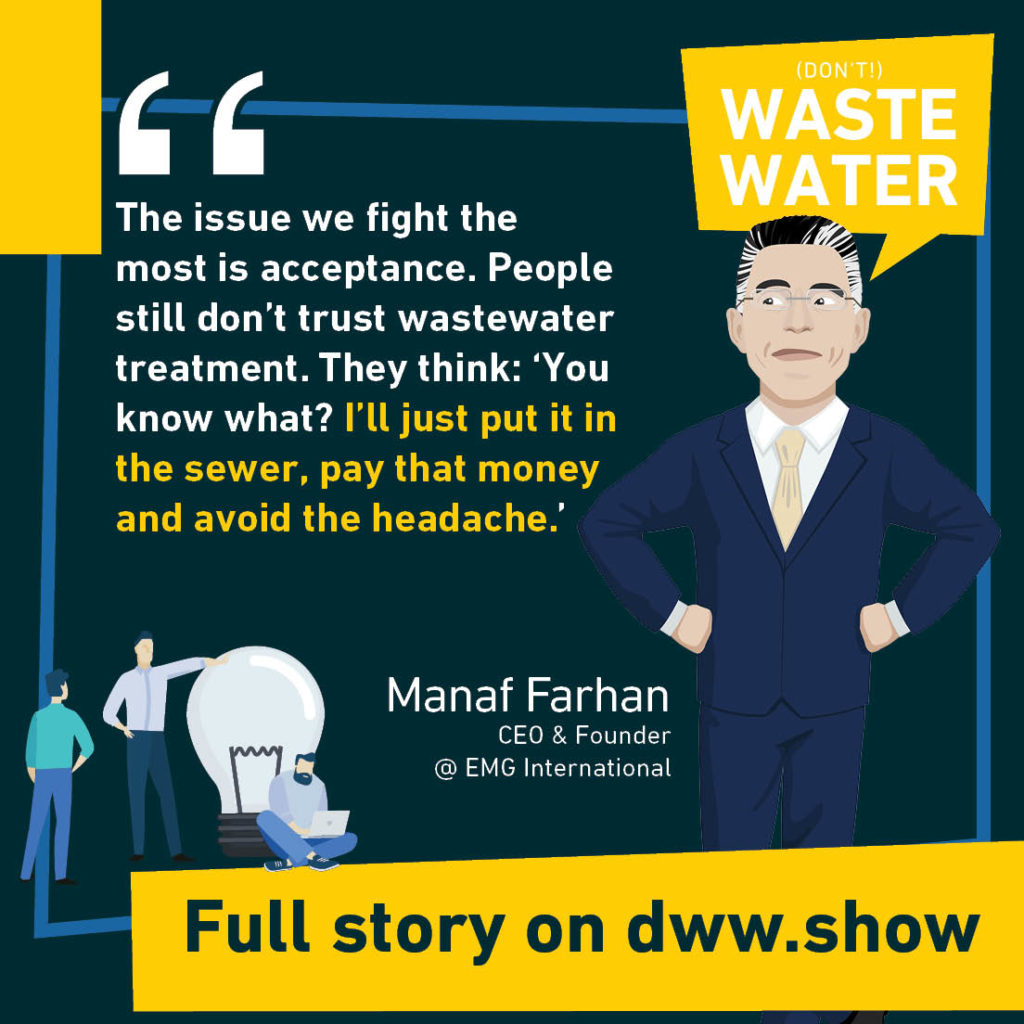
Antoine Walter:
It’s funny, because what you explained me here reminds me of a story, which I’ve heard. I don’t know if I’m allowed to tell that story because I heard it of microphone from one of my previous guests, but she was explaining me that she was working on a brewery and they had high organic loads entering the waste water treatment plants. And no one understood where that was coming from. And after days of investigation, they found out that someone was just washing off some tanks after the production of a special beer, which was, you know, a sugar, a beer, one of these party beers. Let’s put it that way. And, and when they were washing that off, it looks like, like water. I mean, it’s wa it was water with sugar, but for the operators, it was not possible to imagine that that was a waste.
Antoine Walter:
And that was a real problem because I mean, sugar in water is fully transparent. You don’t see it for them. It was just a perfect stream. So they couldn’t imagine that that would be the, the, the problem. So when you mentioned this element of automation being a key, I could imagine that you need to avoid trouble. That would happen just because two operator is an absolute expert when it comes to his process, but just has little clue when it comes to water and in wastewater. So what does automation change here? What are you able to automate?
Manaf Farhan:
That’s a great point that you’re asking, because the people who do the production, they know how to make soda. They know how to make cheese and how to make cake. They don’t care about wastewater to them. It’s an afterthought. And yeah, water was a lot of sugar, you know, beer, water with a lot of sugar in it. It’s just, it’s no problem. The guy can probably drink it and put the rest of it down the drain. You know, we have a client that put some ice cream in the trash, and I looked at the ice cream thing, and this is delicious stuff, why you’re wasting it. But of course they have their standards and they have, you know, whatever fits within their packaging requirements. That’s, what’s going to go. So the anaerobic process is sensitive in only that the methanogenesis, which is the step that produces the methane gas is sensitive.
Manaf Farhan:
That’s the bacteria of the five or six different groups of bacteria in the anaerobic digestion process. That is the most sensitive. And they require a pH. They require a temperature. They require loading rate, they required nutrients. So they have these strict requirements for environment that will make them thrive. But if we’re able to maintain these conditions, they will thrive. It will be reliable, and they will produce methane gas and they will treat the wastewater. And so, you know, you can take a world-class athlete and you feed them junk food, and you don’t give them enough rest or training, and they’re just not going to perform. So it’s the same concept here. So we automate pH with application, we automate the wastewater flowrate. We automate the temperature control. You know, we measure, for example, the bio gas generation rates. We also measure liquid levels and equalization tanks in the chemical feed totes. We keep these things on a strict diet and a strict under strict environmental conditions. When we do that, that’s how we optimize the performance.
Monitoring organic loads in anaerobic digestion
Antoine Walter:
You keep them under a strict diet, but you’re not monitoring the organic loads. How’s that possible?
Manaf Farhan:
We are actually, we are monitoring the organic loads. You can monitor the bod of the wastewater coming in, or the Cod of the wastewater coming in. It’s expensive. You know, it can, an inline Cod meter is about a hundred thousand dollars US
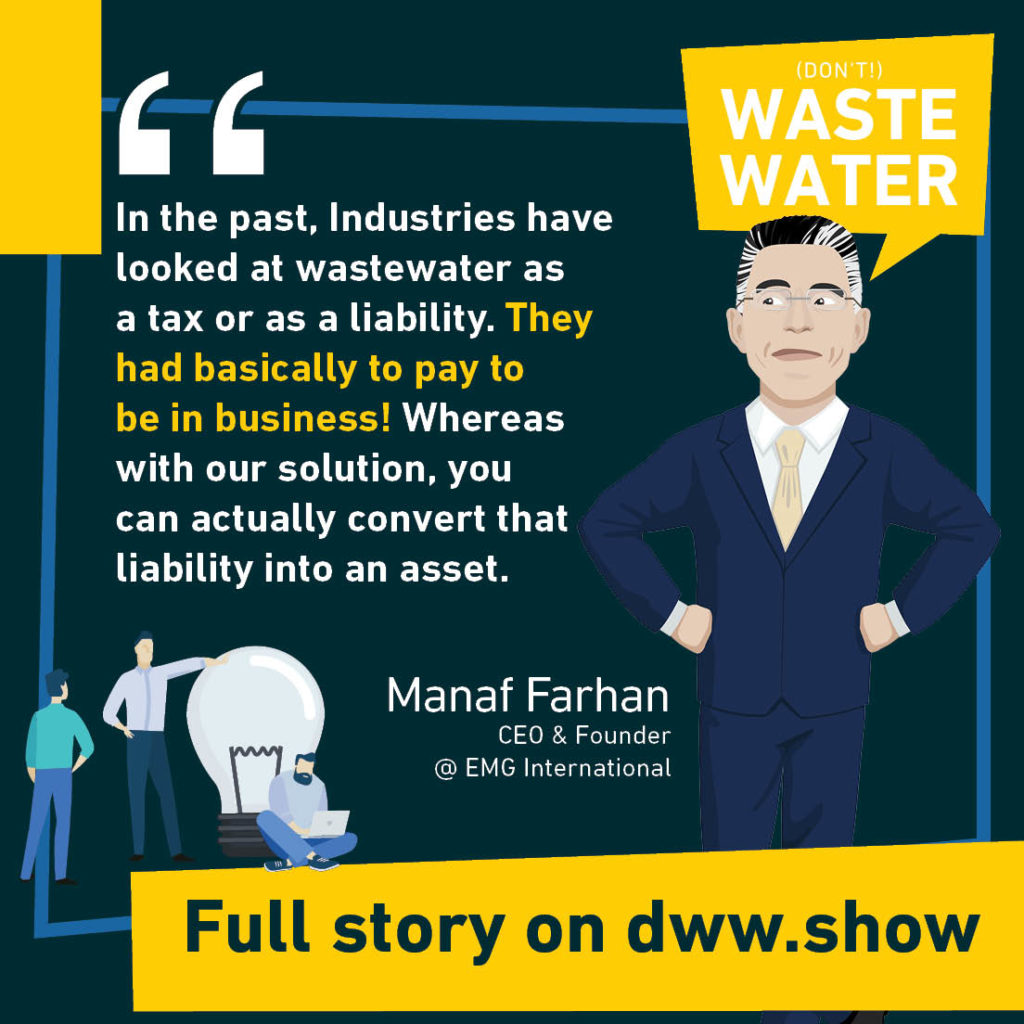
Antoine Walter:
You mean spectroscopic sensors?
Manaf Farhan:
Yes. Some are not as expensive. You can do like these photo cells that can do it cheaper based on solids, but these, the solid cells are only as good for waste with high solids. They’re not good for wastes with dissolved organics, like sugar production, for example. So there is technology out there that you can monitor the strength of the wastewater coming in, but here’s the thing, understanding the anaerobic process itself. And with the high flow rate that we have in our reactors, our reactors respond within 15 minutes of introducing higher strength wastewater. So if you give, let’s say, they’re used to getting wastewater with a BOD of 3000 milligrams per liter at, let’s say, 50 gallons per minute. You keep the 50 gallons per minute, and then you give them 10,000 milligrams per liter. Within 15 minutes, you’ll see a spike in the bio gas generation, 15 minutes, you’ll see a higher bio gas generation rate, higher pressure, and higher biogas generation. And so we have the ability to modulate the performance of the reactors and the operation of these reactors based on the bio gas generation. Cause it’s a very short reaction time.
Automating an anaerobic digestion plant
Antoine Walter:
You get this, this sign, which tells you that organic load is just going through the roof. What did you do with this information? Do you cycle it back to the operator and saying, Hey, that doesn’t sound like something that should happen. So maybe you shall have a look at your process. Maybe there’s something which is open, which should not, or are you just using equalization tank and wait for it to be a bit easier to treat or in the right window or
Manaf Farhan:
We do use equalization. And typically it’s about a half a day of the flow of the plant. So it’s pretty small size. Once you have more biogas generation, it means that there’s more organics going through the process. And of course it’s going to be, it’s a step process. And so the funny thing is that at that point, when you, when you’re bio gas doubles, for example, you’re going to have other indicators like the asset generation is going to increase and the methane generation will try to catch up to it. And so when that happens, your consumption for chemicals to control the pH, for example, 50% caustic will increase. And so as long as the system is equipped to handle it, as long as we have enough caustic to control the pH of the reactor and the level that we needed, and we’re producing biogas, it will recover. No problem. If we run the reactor at a higher organic loading rate, and it happens that the plant has run out of caustic at that instance, if at that moment, there is no caustic to control the pH of the reactor. Then the pH will start to drop that’s when we alert the operator. That’s when we say you have a problem, you need to stop either look at the strength of your wastewater coming in, or make sure that there’s enough caustic to keep the reaction in balance.
Antoine Walter:
I’d like to come back to operation in just a second, but there’s a last thing. You said you’re monitoring temperature. Are you heating up your system as well?
Manaf Farhan:
Of course. Yeah. So anaerobic reactions, the anaerobic digestion process is optimal at a temperature between 95 and 105 degrees Fahrenheit. So in French, that would be about 35 and a half to maybe about 38 degrees, maybe 40, even.
Antoine Walter:
Thanks for the translation.
Manaf Farhan:
No Problem. When I need you to translate cubic meters to gallons later. So it was good. But so we do the anaerobic digestion. It’s the same bacteria we have in our intestines. And so they’re used to 35 and a half degrees, C 95 degrees F. And so if the temperature drops, they’re going to have a stomachache. If the temperature drops, they’re not going to be able to produce. As a matter of fact, there’s a precipitous drop in the Midtown Genesis activity. Once you go below 85 or 80, 84 degrees Fahrenheit. And so we have to bring it up to the optimal temperatures between 95 and about 105, even 110 for those bacteria to produce optimally,
The business side of an anaerobic digestion company
Antoine Walter:
We’ve discussed a lot of technical stuff since the beginning of this conversation, which is fascinating to me, but I would have also a couple of business questions. You mentioned operation. And I was wondering if, if the system is, is so much automated, I mean, if there’s so much that you can actually automate, is it also within your reach to operate it instead of the operator to do like remote monitoring or even remote operation?
Manaf Farhan:
Of course, absolutely. So we design a programmable logic controller or a PLC panel that reads the temperature and the pH and the flow rates and liquid levels. And the pressures from 20 or 30 IO cards. And we take that into a SCADA screen, a supervisory control and data acquisition that basically automates the performance of these criteria within certain ranges. And you can actually remote access that you can access that from where you are in France. Right now, I could give you a login to some of our systems in the United States, and you can change some of the parameters. We could do it worldwide with the internet, which is the great thing about new technology. We’re using it to our advantage. So we can actually, we have several systems that we operate remotely and we can change the parameters based on what we see, because we log on remotely from our office and we see several systems and we can change wastewater flow. We can change temperature, we can change pH control with cost of condition. So all these things we’re able to do remotely, which makes the system performance that much more reliable.
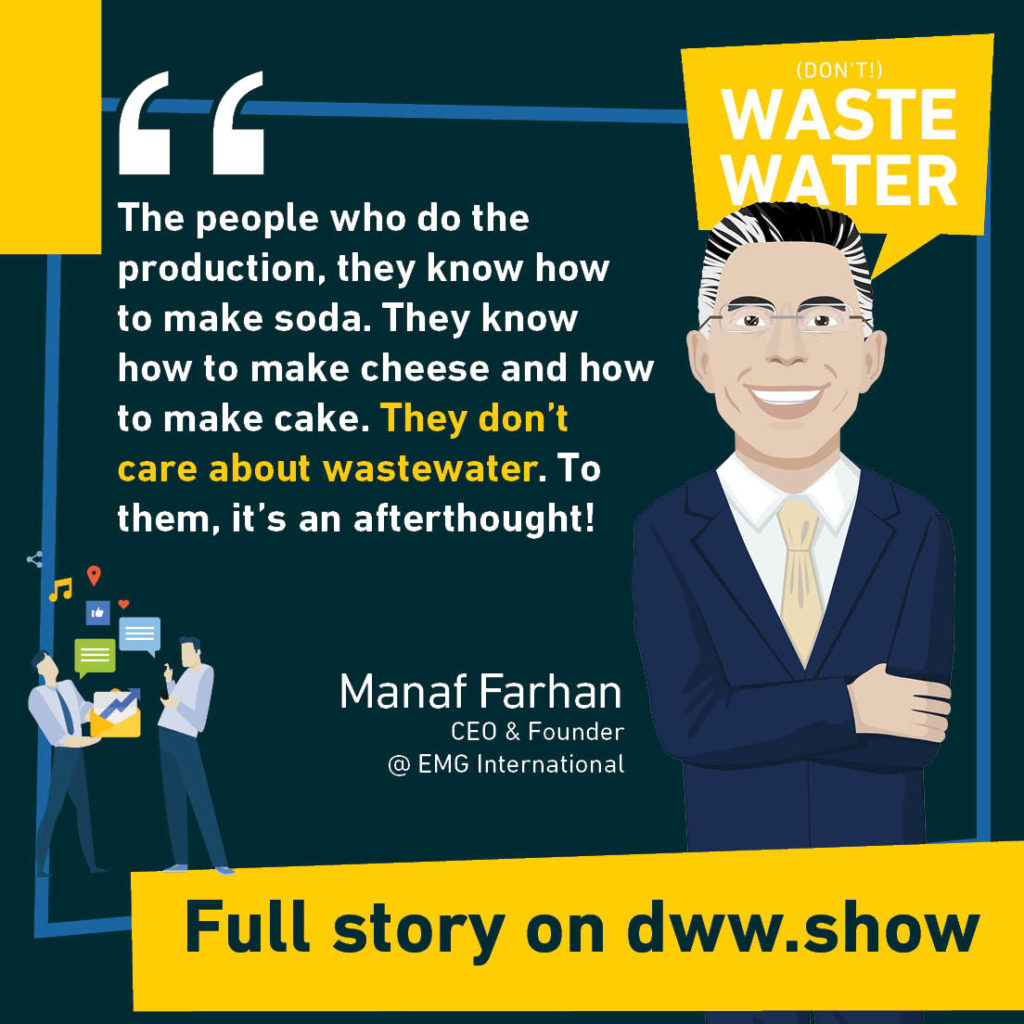
Antoine Walter:
The reason why I’m curious about that is that because again, when I was preparing for this discussion on your website, I saw that you have some, some options for financing. So basically zero money down for still me as a customer. So an industrial player, and I was wondering that’s still leasing or rental or of financing, but would it be possible to go to the next level then to say, you put something on premise for the industrial player, but you would actually fully operate it remotely and you would sell a treatment capability or why not sell energy? Is it something which is doable? Or is it science fiction?
Manaf Farhan:
No, no, it’s very doable. So yes, we do lease and rent these units to clients. So that, of course there’s a lot of financial stresses on them because they want to make sure that they’re profitable. And so we lease them or we rent them to make the costs on their balance sheets, more on operations rather than on a capital
Antoine Walter:
As you turn a CAPEX into an OPEX that that’s, to me, industrial, it’s a, yeah, it’s great.
Manaf Farhan:
Yeah. But the, the other thing is we also offer service plans where we provide long range, you know, remote tech support. We can provide more onsite, you know, on a periodic basis, or we can run the system entirely. And the benefit of having our systems so highly automated is that the required manpower to do this is very little. So our systems, we have systems that can handle upwards of 20,000 pounds of BD per day, five digestive units. And they need two hours a day of operator time because they’re almost fully automated. So we also offer the option to install these systems, finance them, and operate them for our client.
What about international expansion?
Antoine Walter:
You’re called EMG international. How international are you?
Manaf Farhan:
A lot of people ask me that question. First of all, personally, I’m from Jordan. So I came to the United States to go to college. So in itself, that is some somewhere, you know, crossing international borders.
Antoine Walter:
It’s already very international!
Manaf Farhan:
But we also have partners in Canada with a trans altar is a large utility in Calgary, in Alberta and they’re equity owners, they’re our partners. And they believe in our mission and they support us with what we’re doing with treating wastewater sustainably.
Antoine Walter:
So it’s a really a North American focus if I might say so.
Manaf Farhan:
Yes it is for now. It is TransAlta has offices in Australia. We have consultants in England in London, which used to be part of the EU. Unfortunately, you people throw them out or are they jumped off the cliff, whichever you want to call it. So we are interested in the European market and the South American market as well.
The sweet spot of anaerobic digestion
Antoine Walter:
What’s the sweet spot for your technology, because we said it’s high strength wastewater, but where does that start? And when, where does, does that ends? I mean, maybe that doesn’t end, is there an upper limit and a lower limit where you would say you’re the best suited technology? Yeah.
Manaf Farhan:
So our technology is a lot of times it’s driven by cost to the client because of what they spend on their wastewater, if a client ships their wastewater offsite, because they’re not allowed to put it in the sewer because it’s above a certain threshold, then it becomes a lot more financially feasable because shipping costs are higher. If our client’s costs are driven by compliance or by you know, they’re putting too much to the sewer and they, they have surcharge there, then it’s a different conversation. So for us, if we’re talking about just the technical application, anything between, I would say 2000 pounds of BOD, do you use BOD and France? Is that an indicator? Yep. Okay, great. So anything between 2000 pounds, I asked you now 45 minutes and write anything between 2000 pounds of BOD on up, up to even a hundred thousand pounds of BOD, we can handle it is modular.
Manaf Farhan:
So every unit will handle a certain amount of BOD per day. High strength waste becomes our specialty because a lot of biological wastewater systems shy away from strong, very strong wastewater, for example, whey, which comes from cheese manufacturing or yogurt. Manufacturing is very high strength. It can have a COD of a hundred thousand milligrams per liter, and that’s very difficult for Aerobic systems to handle. And if you’re putting it through other digestive systems, you have to watch the flow rates, et cetera. That becomes where we Excel. We also Excel in areas where footprint is very limited because we have the highest allowable, organic loading rate in the industry because we have the highest biomass population in the reactors. And so we require the smallest footprint
Antoine Walter:
That you were founded in. You founded it actually, it’s not, you were founded, you founded it in 1996. So that makes 25 years of history, which is already much of a milestone. How big are you today? How many people are working for EMG?
Manaf Farhan:
We’re a pretty small company. We are a very dynamic team where between us and TransAlta obviously it’s a different count right now. We have the ability to expand very quickly by bringing in people from the TransAlta team, because they give us all the engineers and a lot of resources. And so to answer your question, it depends on how you count it.
Antoine Walter:
No, I wasn’t asking to push you in a corner. It’s because, you know, one of my latest guests Gaetane Suzenet, on that microphone express that in the, in the water industry, there, there’s a very strong network of smaller startups or smaller size companies and not so much scale-ups. And we were discussing if the scale-ups weren’t existing, because it’s really technical industry has its niche and specialized applications, or because as soon as you become big enough, you a good prey for a bigger, even bigger players to just do kind of external innovation by buying you in. So I was just trying to, to put you on the map, just in order to shape my next question, which is where do you see yourself in five years?
Manaf Farhan:
We actually, we got to the point where we were a startup 25 years ago, and the first few systems that we built was difficult to get people interested. But once you have the first one in and you prove the results, you get the next one easier and you have to, and then the third one would be easier. We got to the point where we got the attention of the folks with trans shelter. They have a very strong focus on sustainability and renewable energy. And so last year they acquired a part of our business. And so now makes us so much deeper, bigger team in five years, our goal is to have the fluidized bed as the leading anaerobic digester technology in the United States. And in Canada, the market is huge. We have a lot of applications and a lot of opportunity for us to do that. And the market is growing. And so we see really unlimited potential and we can, we can do a lot of help. We can do a lot of good things for our clients in this industry.
How Anaerobic Digestion all started for EMG International
Antoine Walter:
Actually, I sent you to the future, but you just alluded to something in the past, which I’m very interested in. Can you remember the story of your first project? How’d you come to do to remember the plant? It was, it’s something you, you can still talk about. How do you come with a new technology and push it to the market?
Manaf Farhan:
Of course, that’s a great question. One, the first project that we did was in 2003, 2004, and no one would listen to anybody saying, Hey, I have a great technology. This is going to be the best, next best thing. And you have no proof. You have, you haven’t built any other systems. So we built it at a cheese plant and the arrangement was that we would build it on our cost. And once it performs, they will buy it from us. And so we borrowed as much money as we could to be able to afford the equipment is very expensive for us at the time. We’re a very small company. And by some miracle we put a very first system in place. We put that tank in place and my brother and I he’s my partner. We built that first system with our hands. We’re both engineers. Wow. Well, we use some help from local plumbers and local electricians, but we, we did the majority of the work ourselves. We’re trying to cut costs and make sure it works. And I’ll tell you one thing, that first system that we put online in 2004 is still working today.
Antoine Walter:
So basically the question I was asking you, if you’re going to market it as a service, that was what you were doing from day one. Actually, you were, your first plant was a plant as a service.
Manaf Farhan:
Yeah, we had to do that because you know, it’s hard to sell expensive solutions, multimillion dollar solutions, if you don’t have the track record, but we believed in the technology and I saw firsthand what this technology can do. And that system that we built in 2004 is one of our best systems is still operating. And we take people there and we show them, it’s like our history. We show them that digester. I wish I could show you a couple of pictures, maybe at another time, but it’s you know, that, that initial setup was a service that we would put an in place, treat your wastewater, reduce your surcharge fees, get you in compliance. And that’s how we both benefits. And that worked out well.
Antoine Walter:
And when is the last time that you’ve been involved in, I mean, directly involve hands-on on the building of a plant.
Manaf Farhan:
So it’s been a while. Our company now is broken into divisions and the operations division, which is headed by my brother USR. He designs these systems and he has a team and they execute and they build them, him and I still interact on the design and some of the details of the 10,000 foot level for the design and the sizing and the layout, et cetera. And he takes the lead on the execution. And I do other things for the business, but personally, I haven’t done one of these in several years. I do miss it. When I go to see them, it’s exciting because it’s like, you know, seeing something that you’ve created so many years later, it’s just, you know, being done on a much bigger scale. Now it’s really exciting
Antoine Walter:
Well Manaf, we’ve made a good tour on that topic, I would have, you know, further question. But at some point I have to be a bit cautious of your time as well. I propose you to switch to the rapid fire questions.
Rapid fire questions.
Antoine Walter:
Don’t worry. In this last section, I tried to keep the questions short and ideally you will keep the answers short as well, but don’t worry. It’s always me who is going to make it much longer than I should. So if there’s anything you want to explain a bit more on the immature itself. So my first question is what is the most exciting projects you’ve been working on and why?
Manaf Farhan:
That’s a good question. So we’re working. One comes to mind immediately, we’re working on a bean plant. It’s a very large plant over a million square feet under roof, and they have several different products. It’s the highest flow that we’ve handled designed for upwards of 750,000 gallons per day, which is a lot of flow of onto these digesters. We’ve dealt with a lot of challenges in terms of getting the wastewater there and getting it to how we needed to go to the digesters and the layout and planning for expansion. And one of the best reasons I like working with that client and on that project is that they’re so excited about what we do and the technology and what we can do for them. It really feels that we’re a team. Those are the ones I enjoy the most. And, and those guys are just really, they’re nice people to work with. And they’re genuinely excited about what we can do to help them reduce their carbon footprint. And that’s why I really love that project.
Antoine Walter:
Are you allowed to say where that project is? Sure. It’s in
Manaf Farhan:
A Fairbault, Minnesota. It’s a Fairbault foods in Minnesota, which is about one hour South of 45 minutes, South of the twin cities, Minneapolis and St. Paul. Now I might ask you as a French man to tell me how to pronounce Fairbault. If you can look it up,
Antoine Walter:
I’ll check that. What’s your favorite part of your current job? I would say
Manaf Farhan:
Creating and designing better solutions and reliable systems, especially when we’re told it can’t be done. When someone tells you no way it’s not going to fit, or it’s just not going to work. And when we do this and we’ve make it work and they come to us and say, thank you, that’s very gratifying.
Antoine Walter:
Do you still get people telling you it’s not going to work even after 25 years,
Manaf Farhan:
There’s people out there that tell you that we haven’t landed on the moon?
Antoine Walter:
Sure.
Manaf Farhan:
It’s changing the mentality. You know, the wastewater industry is very old. It takes time to change and people have to see it to believe it. There are people who are believers in the science and the technology and, and when they see data and there are people who are just skeptical by nature and you just have to prove that it works
Antoine Walter:
Well. You mentioned it’s an old industry. So the next question is going to look at the future of the industry. What is the trend to watch out in the water industry?
Manaf Farhan:
I believe sustainability is a big trend in the water industry. You know, reducing the carbon footprint, treating sustainably, reducing water consumption. And the other thing is automation. I think those two are in the next 10, 20 years are going to be at the forefront of innovation in the water.
Antoine Walter:
Actually, you know what? I warned you, I’m always the one to sidetrack, but know that you mentioned that to Mason. I was wondering when you were explaining how much of the resistance do you still have to overcome when you tell to industrials that you can have remote access. I mean, you, you gave the example that you could give me access from France to the blends you have in the States. Is it something where people are worried about or they get that it’s going to be safe anyways? So
Manaf Farhan:
A picture is worth a thousand words. We have that saying in English. I don’t know if you say it in French, but the best thing is when we’re at a meeting with a client and I mentioned automation on my laptop, I log onto one of our systems and I show them how it’s working. I show them the flows and the pH control and the temperature and the Biograph generation and the electricity being generated every second. And once they see it, you see the transformation in their eyes like, wow, this thing is real. And it works. And we do the design for the SCADA screens so that it reflects reality. So the operator can actually trace what they’re seeing on the screen with what’s happening on the ground. And it’s really neat. And I think that part of it is the great thing about having these tangible systems, these big, you know, actual system that are on the ground that work is that you can touch them and you can feel them and you can see them. And so that part of it, it’s easier now to produce once you’re, you know, once you have these systems working, it’s easier to convince people that these things work well. When at the beginning 25 years ago, that was a bigger challenge. There was just a vision that we’re seeing that we can, what we could do. And thankfully we were able to do it.
Antoine Walter:
What do you bring? Bringing transparency somehow? So you you’re breaking down kind of a barrier for people waste wastewater. It’s something they couldn’t grab seeing things on a screen which tell them it’s good, or it’s not good. I think it’s something which has no pun intended, but it’s digestible a bit, a bit better for them. I was wondering when you’re going to do that
Manaf Farhan:
Excellent reference. I like,
Antoine Walter:
What is the thing you care about the most when you’re working on a new project and what is the one you care the least?
Manaf Farhan:
The most important thing for me and for our team on these projects is to be prepared it’s to understand the depth of the problem or the situation and understand their limitations, understand their permit, limits, understand how they operate. So for us, the more information we have the better, because when we know something, we can prepare for it. So for me, obviously it’s important that you have buy-in from the client and that they’re committed, but we need to know what’s happening at their plant and their limitations. So we can custom design the solution that works best for them. The thing I like the least, obviously dealing with large corporations, there is a lot of politics and personalities, and a lot of times the politics part, I don’t enjoy too much.
Antoine Walter:
Okay. I don’t know if I’m allowed to say it because you don’t name it on your website, but you have a picture, but it’s a, it’s an energy drink, not the one that gives you wings. The other one is it’s difficult to deal with such a huge customer, as opposed as I guess the dairy farm.
Manaf Farhan:
So here’s the thing. Everything has pluses and negatives. So when you talk, when you deal with these bigger corporations and they have teams and they have, you know, budgets and they have schedules that you have to fit, these things are good because they define your mission and what you have to do and your goals, but they’re also, they could be amazed. You know, when you talk about their EHS or when you talk about they’re all these departments that come and give you the review and what you have to follow. So it could, it could get complicated. We haven’t done dairy farm projects in over 10 years. We’ve transitioned now more to industrial wastewater treatment, food and beverage because of the need is much bigger there. But you know, I have to say at the end, Antoine people are people and I enjoy working with people and finding out what their problem is and helping
Antoine Walter:
That’s the positive way to summarize it. Do you have sources to recommend, to keep up with the water and wastewater market trends?
Manaf Farhan:
Sure. Yeah. I often go to conferences and I take part in sustainability forums. I mean, if I have to give you one, there’s a lot of good things, but maybe, you know, the water environment association, we, they have them in every state here in the United States, they have these seminars and that I participated in, you know, they they’re helpful. And obviously reading blogs and sites, websites that have updates with is helpful. What do you mean?
Antoine Walter:
Well, I was going to tell, you know, it’s refreshing because you’re not giving me the one that everyone gives usually, which is LinkedIn. I’m using LinkedIn a lot, but sometimes, and not something we think it’s good to to be to be a bit outside of kind of formatted environment and to good. But aside from what the algorithm tells you is interesting to you. So
Manaf Farhan:
Yeah, we use a lot, don’t get me wrong. We use LinkedIn and we’re on LinkedIn. But you know, there’s, there’s a lot, it’s,
Antoine Walter:
It’s refreshing to hear that it’s not your primary source because it doesn’t get me wrong. I mean, I love LinkedIn, no, some source of, of many stuff and men, but, but sometimes, you know, the algorithm has the shape of things. He, he loves a bit better than others. And so a very interesting topic can be buried just because it’s not in the right shape and something, which is yeah, arguably not, not of upper importance just gets pushed a lot just because it’s in the exit white shape, not doing any kind of LinkedIn shaming, it would be the wrong person to, to tell that. But yeah, that’s the question on my end. Would you have someone to recommend me that I should definitely invite to to be your follow up on that microphone?
Manaf Farhan:
Let me give that some thought. And I have email address and I can, let me ask if a few people want to have in mind would be interested. Your focus is obviously on wastewater, so I’ll keep that much.
Antoine Walter:
Well, my focus is on every cool story, which is around that. So it can be wastewater, but it can be really I had fun discussions with her, which had little to do with a, with a wastewater, but had to do with, with water as a broader topic. But anyone listening to that, it’s just I’d like to thank Jared, Jared Paul, which I’m mentioned as Paul, Jared, I’m sorry for that. So Jared, he was the one making the introduction and making sure that, that whole discussion we just we just had, so, yeah.
Manaf Farhan:
Yeah. Well, thank you very much for your time Antwan. I appreciate it. And I appreciate your interest.
Antoine Walter:
Well, thanks for that manner. And yeah. Talk to you soon, maybe in five years to check out if and how you became that leading technology for food and beverage wastewaters and here.




